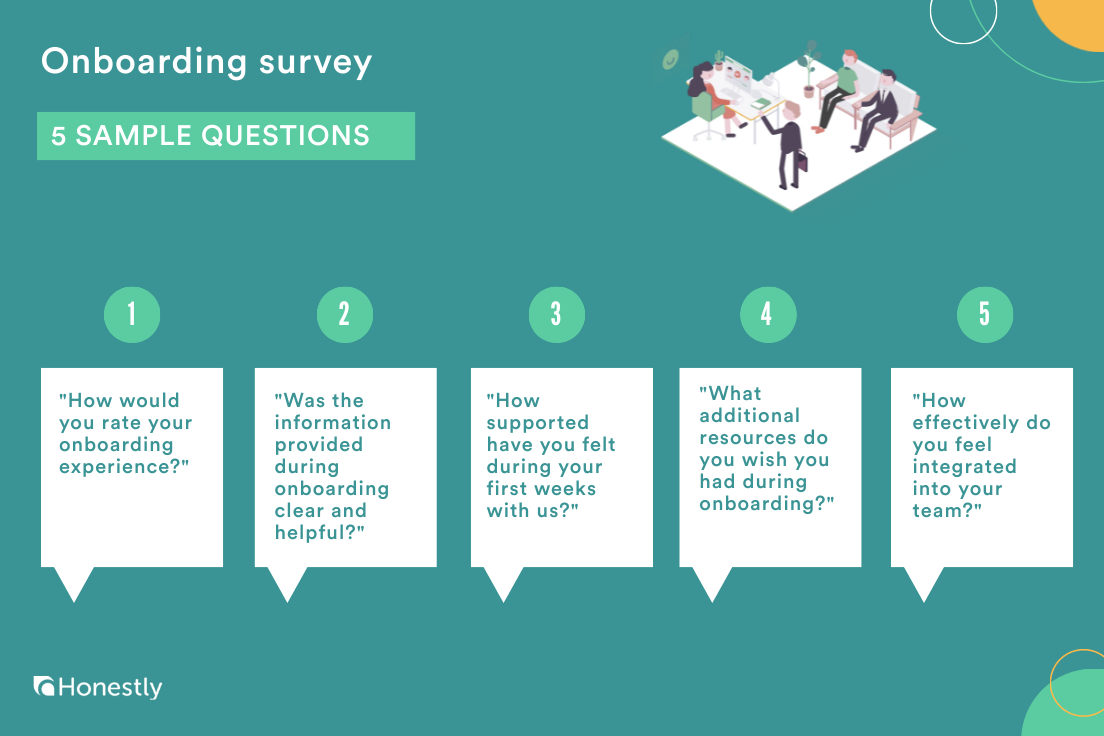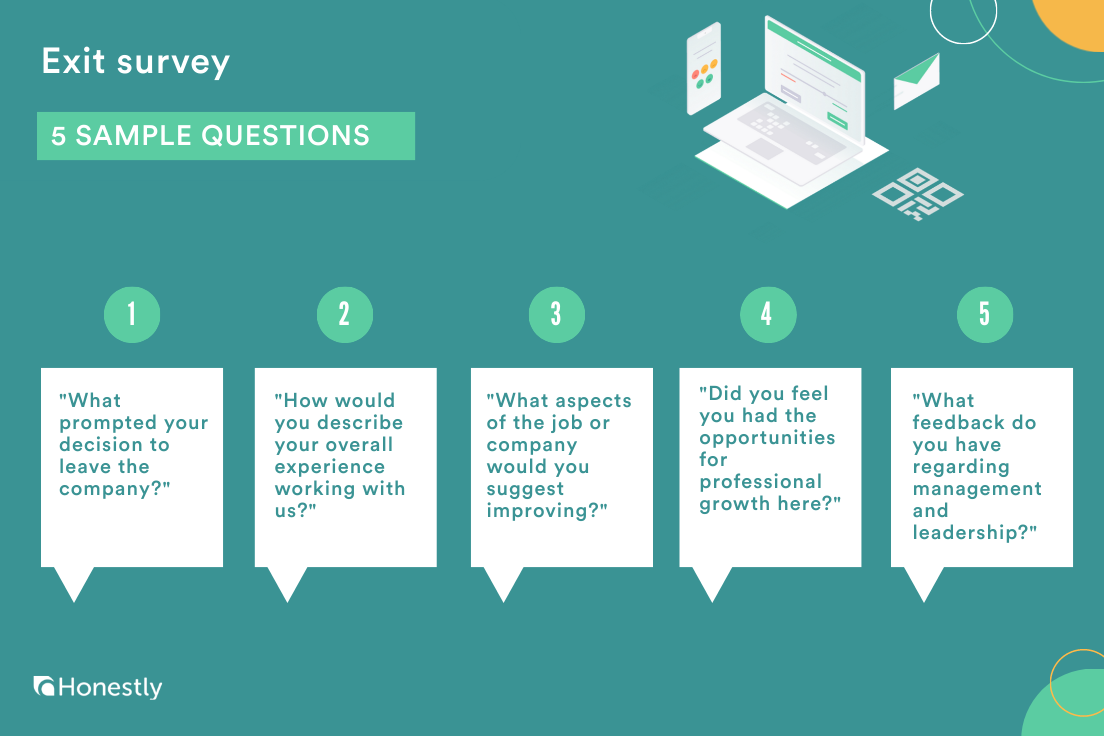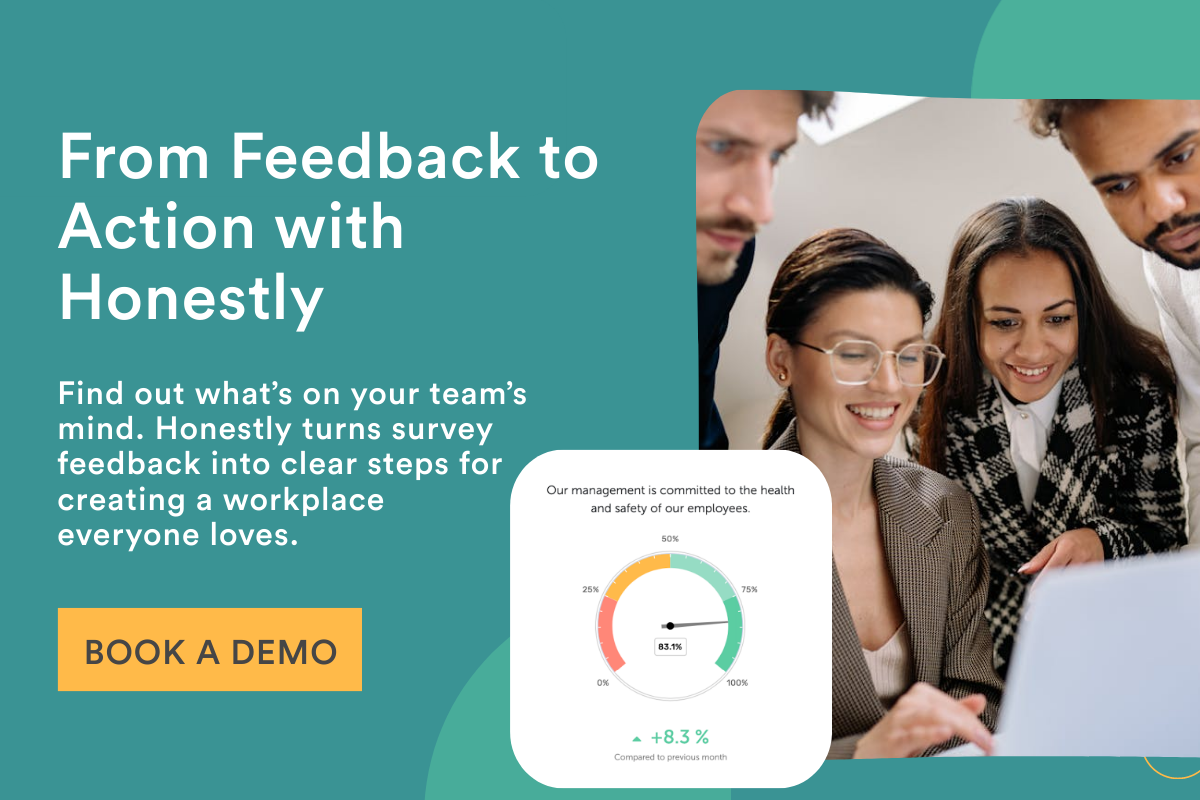
Table of Contents:
- What is an Employee Survey?
- Why Employee Surveys Are Important
- Key Types of Employee Surveys
- How to Design Effective Employee Surveys
- Employee Surveys Best Practices
- Final Thoughts
Ever wonder how your team really feels about their work?
That’s where employee surveys come in handy.
They act as your company’s pulse check—highlighting exactly where you can level up and thrive.
In this guide, we’ll walk you through why employee surveys are essential for any business and how to master them every time.
Ready to get the inside scoop on your team’s thoughts and boost performance like never before?
Let’s dive in.
What Is an Employee Survey?
An employee survey, or staff survey, is a questionnaire used to assess the overall sentiment, engagement, satisfaction, and performance within the company.
It’s a tool that lets you tap into your team’s thoughts and feelings about their workplace.
For example, a software company could use employee surveys to collect feedback on remote work policies.
Or, a manufacturing business might leverage them to understand how employees feel about organizational changes.
Conducting employee surveys is key to giving your employees a voice and gaining actionable insights for your company.
Why Employee Surveys Are Important
Ever wondered what magic ingredient keeps top companies thriving?
It’s simple: they listen.
Employee surveys are that bridge between guesswork and knowing what your team really thinks and feels.
They’re essential for any industry and any business size.
For example, they can help maintain greater visibility in large corporations spanning multiple locations.
Or they could ensure a positive work culture and transparency in fast-growing startups.
Let’s look at the key benefits of conducting workplace surveys.
1. Ensuring Open Communication and Trust
Acting on survey feedback means you’re building trust.
This open line can transform your workplace environment and keep your talent right where they belong—with you.
For example, using surveys, you can uncover various insights, such as:
- Areas where employees seek more transparency from management
- Specific feedback on how team meetings can be more inclusive and productive
- Employee suggestions for fostering a more collaborative team culture
2. Improving Employee Retention and Engagement
It’s no secret—boosting employee engagement and decreasing turnover is key to your company’s financial stability.
Surveys can clue you in on what keeps your team ticking, reducing employee churn, and fostering a committed workforce.
Gallup’s 2023 research shows that 59% of employees engage in “quiet quitting,” doing the bare minimum and feeling disconnected from their work.
However, these employees often know what changes they want in their workplace, especially regarding engagement and culture (41%).
Think about the positive change you could create by simply talking to your teams.
3. Collecting Actionable Insights
Ever heard the saying, “Knowledge is power”?
Employee surveys provide a wealth of knowledge, guiding your next moves and sharpening your competitive edge.
For example, a staff survey can help you pinpoint exactly where your team needs support and uncover insights such as:
- The desire for more professional development opportunities
- Feedback on management styles
- Suggestions for improving workplace culture
4. Spotting Trends and Gaps
Beyond individual feedback, surveys can reveal broader trends.
Is there a widespread need for more flexible work arrangements, or perhaps, a craving for more learning opportunities?
Here’s how you find out.
For instance, CleverShuttle used Honestly’s employee survey tool to uncover unexpected insights about their workforce.
With their team growing incredibly fast—from three employees to 170 in five years—the company wanted to ensure employee satisfaction.
Imagine this: a whopping 80% of their staff eagerly chimed in on their very first survey.
But here’s where it gets really interesting.
The data highlighted a gap they hadn’t expected: their female employees weren’t as content as their male colleagues.
Quick to act, CleverShuttle got all hands on deck, holding a focused meet-up with the women in the team to drill down on improvements.
The outcome? An impressive leap in satisfaction scores.
Remember, the success of employee surveys depends on how seriously you take them—and the actions you take afterward.
When done right, they can act as a powerful driver for your company’s growth.
Key Types of Employee Surveys
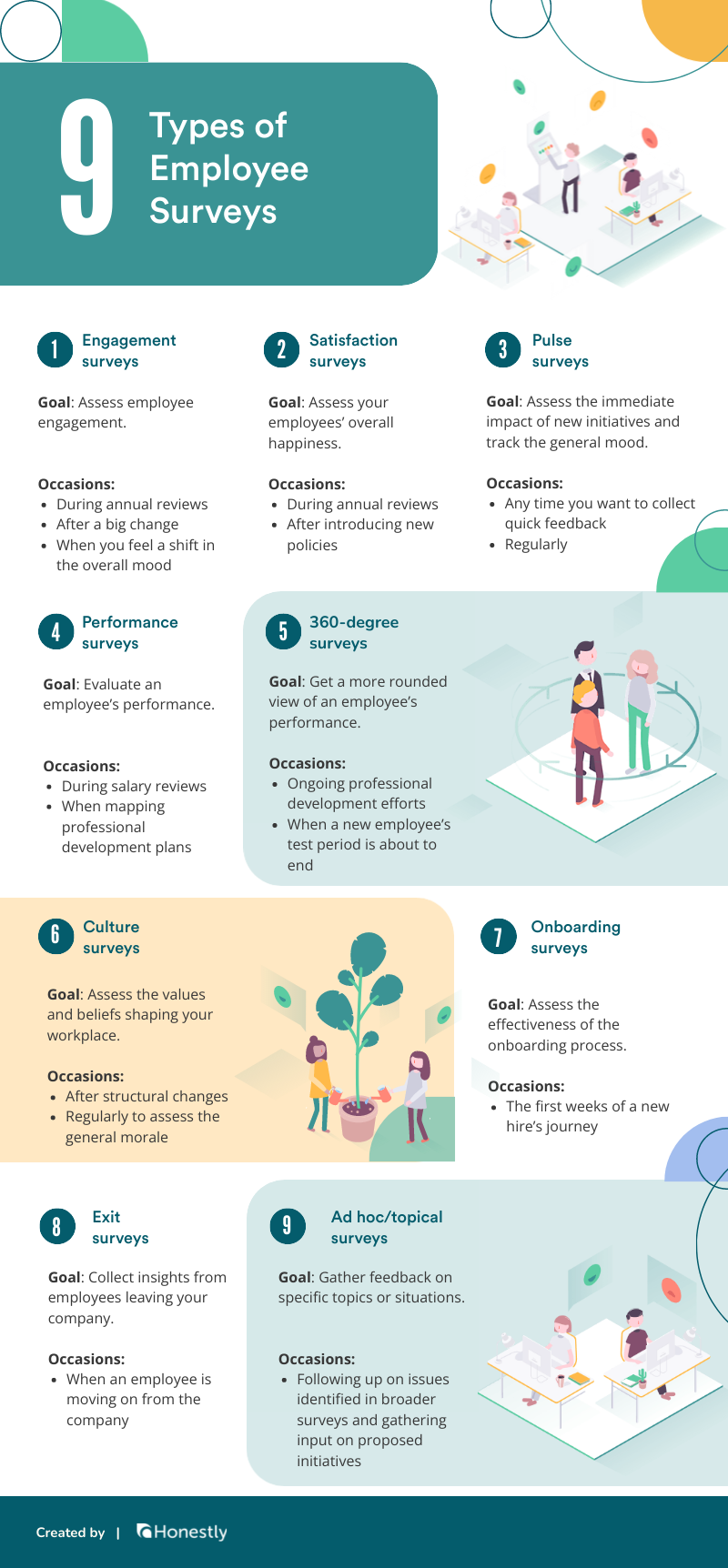
Different employee surveys serve varied purposes—from measuring engagement to pinpointing specific areas for improvement.
Let’s explore the key types of employee surveys and understand when and why you should use them.
Employee Engagement Surveys
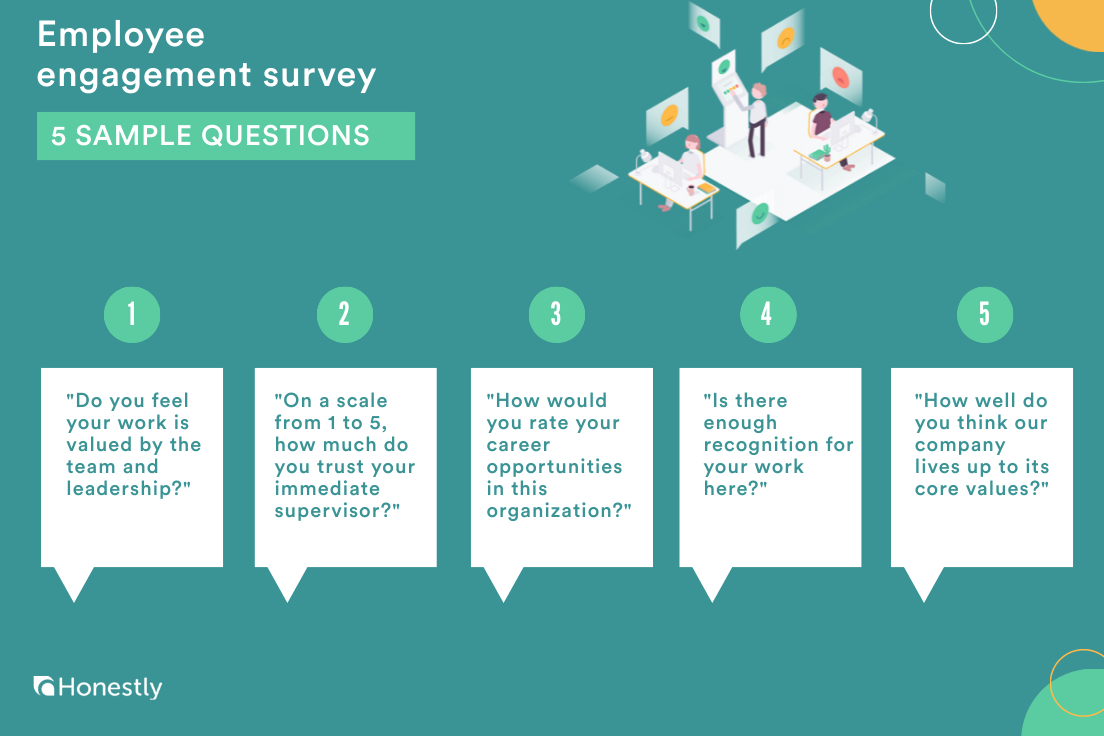
Employee engagement questionnaires assess how deeply employees are invested in their roles and the organization itself.
Think of them as a deep dive into the workplace climate, revealing insights that might not surface in day-to-day conversations.
When to use them:
The perfect timing for an employee engagement survey?
Think about those moments when you’re trying to get a deeper understanding of your team’s morale.
For example, it could be after a big company change or when you sense a shift in the overall mood.
It’s also a good idea to execute those surveys regularly to monitor the overall work environment.
Sample questions:
- “On a scale from 1 to 10, how motivated do you feel coming to work each day?”
- “Do you feel your work is valued by the team and leadership?”
- “How well do you think our company lives up to its core values?”
- “Is there enough recognition for your work here?”
- “Do you see yourself growing within the company?”
Download a free employee engagement survey template here.
Employee Satisfaction Surveys
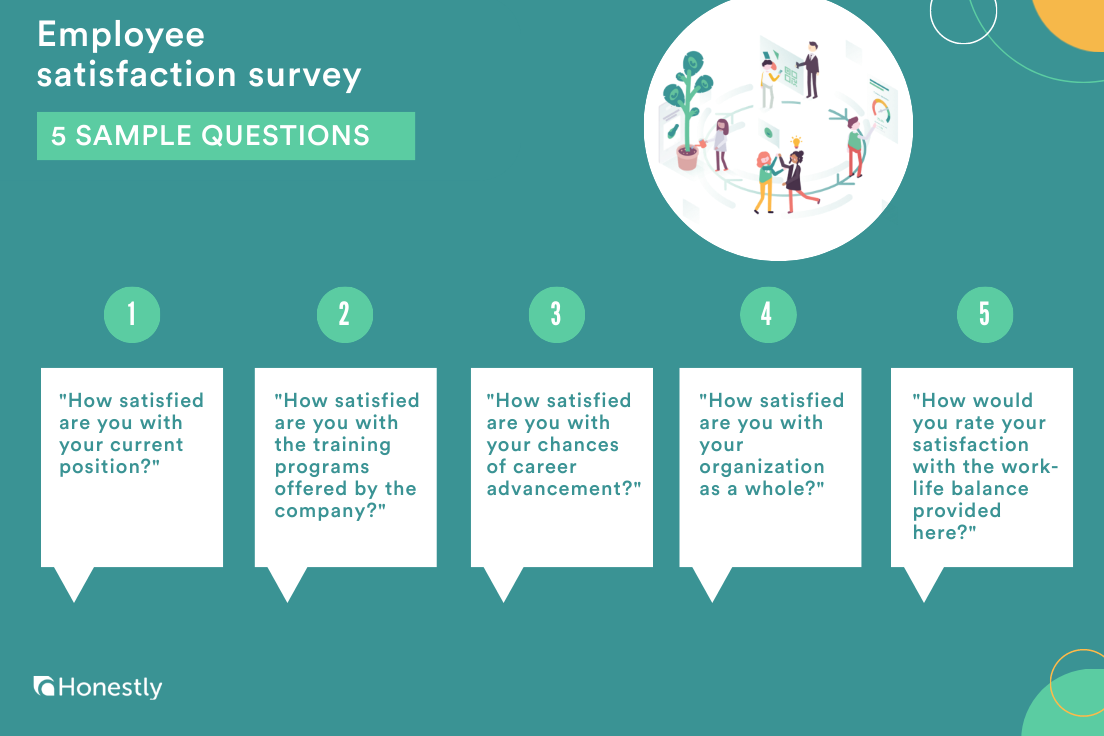
Employee satisfaction surveys help you assess the overall happiness of your employees— directly tied to their day-to-day experiences and their sense of fulfillment at the company.
It’s an effective way to get the pulse on what’s working well and what could use a bit of a morale boost.
When to use them:
Employee satisfaction surveys are especially useful when you’re looking to get a holistic view of employee well-being.
Ideal occasions include after implementing new workplace policies, during annual review periods, or any time you want to improve the overall job satisfaction within your team.
Sample questions:
- “How do you feel about your current work and the responsibilities it entails?”
- “Do you believe the company supports your overall well-being effectively?”
- “How would you rate your satisfaction with the work-life balance provided here?”
- “In what ways do you feel valued for your contributions to the company?”
- “What improvements would most contribute to your job satisfaction?”
Download a free employee satisfaction survey template here.
Pulse Surveys
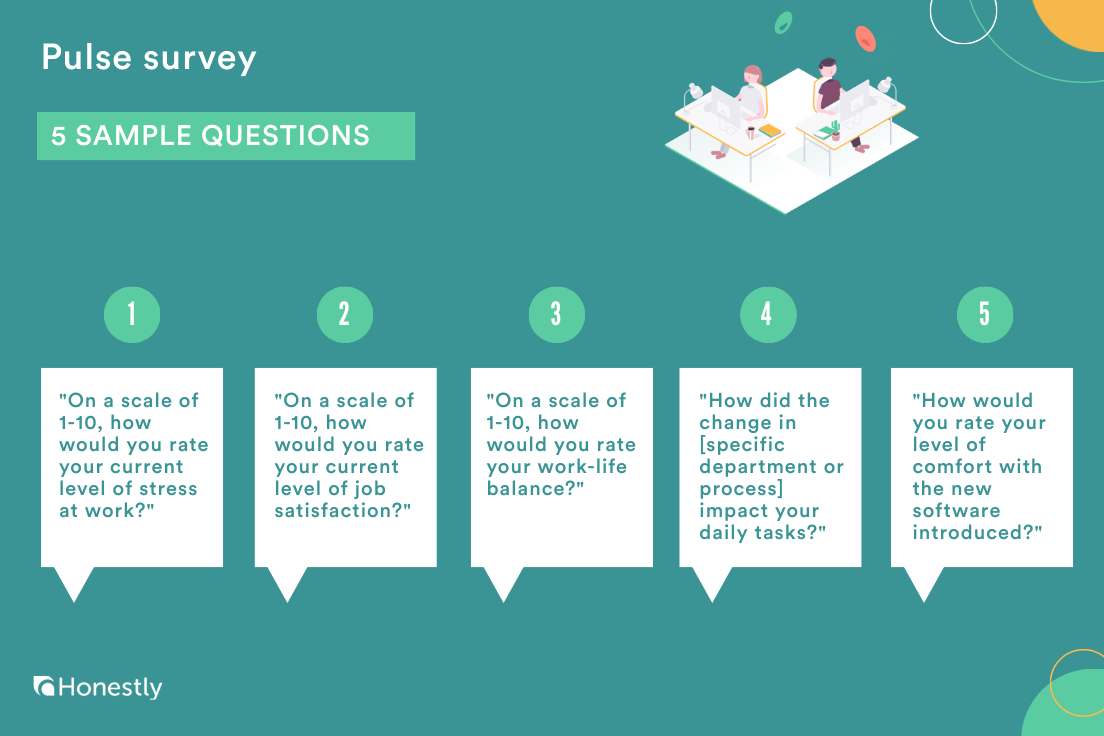
Pulse surveys are short, frequent surveys used to assess the immediate impact of new initiatives or track the general mood in your workplace.
They act like quick check-ins that keep you connected and responsive to your team’s needs without overwhelming them with lengthy questionnaires.
When to use them:
Pulse surveys are incredibly versatile, making them suitable for almost any occasion.
Looking to see how recent changes are settling in?
Or maybe you want to keep a regular tab on team morale throughout the year?
These surveys are ideal for getting timely feedback that helps you stay agile and make adjustments on the fly.
Sample questions:
- “How do you feel about the recent changes implemented in the workplace?”
- “On a scale of 1-10, how would you rate your current level of stress at work?”
- “Is there anything that could improve your daily work experience right now?”
- “Do you feel more or less connected to your team this month?”
- “What’s one thing we could do to make your week better?”
Employee Performance Surveys
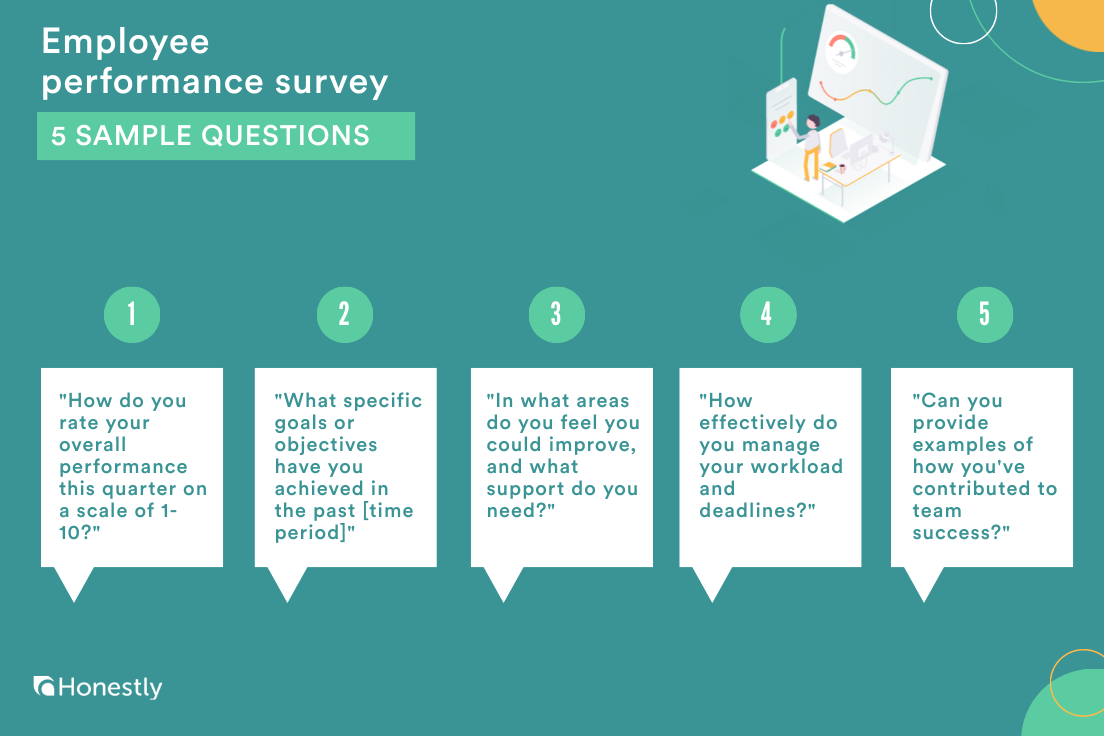
Employee performance surveys dive deep into assessing individual contributions, skill development, and areas for growth.
They’re usually designed to evaluate an employee’s job performance from the perspective of their direct managers or supervisors.
These surveys can also include self-assessment components, where employees reflect on their own performance, achievements, and areas for improvement.
This approach helps to analyze how well employees meet their job expectations and achieve their goals—while also offering insights into their self-perception of work performance and areas for personal growth.
When to use them:
Employee performance surveys are particularly helpful during salary review cycles or when planning personal development plans.
They offer a structured way for managers to provide feedback on an employee’s contributions and areas needing improvement.
Sample questions:
- “How do you rate your overall performance over the past quarter?”
- “What achievements are you most proud of in your recent work?”
- “Where do you see opportunities for personal development or skill enhancement?”
- How effectively does the employee meet their job expectations?
- Can you provide examples of goals the employee has achieved in this review period?
360-Degree Feedback Surveys
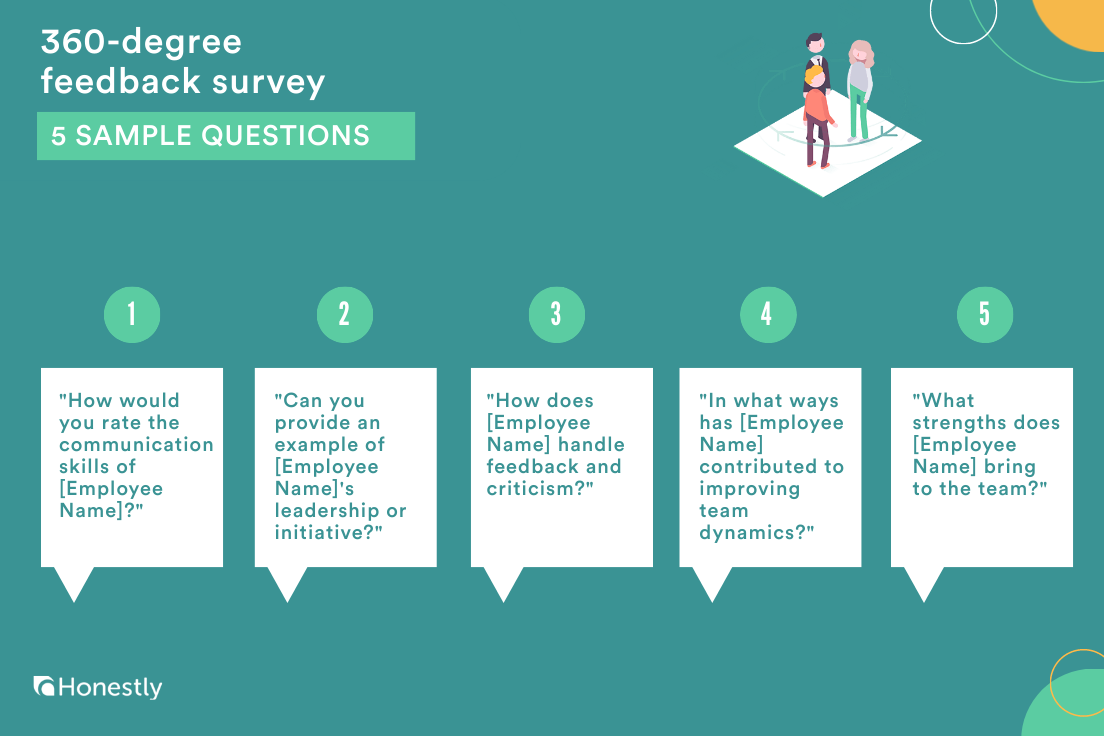
360-degree surveys expand the scope of feedback by collecting insights not just from managers, but also from peers, subordinates, and sometimes clients.
This comprehensive approach helps to get a rounded view of an employee’s performance, skills, behavior, and workplace relationships.
When to use them:
These surveys are ideal for supporting ongoing personal and professional development.
They’re also incredibly useful for gathering peer feedback, especially when an employee’s test period is nearing its conclusion.
They’re especially effective in environments that encourage continuous improvement and invest in nurturing leadership qualities at all levels.
Sample questions:
- How would you describe the employee’s teamwork skills?
- Can you provide examples of how the employee has contributed to project success?
- In what areas do you think the employee could improve?
- How effectively does the individual communicate with team members and clients?
- What strengths does the individual bring to the team?
Culture Surveys
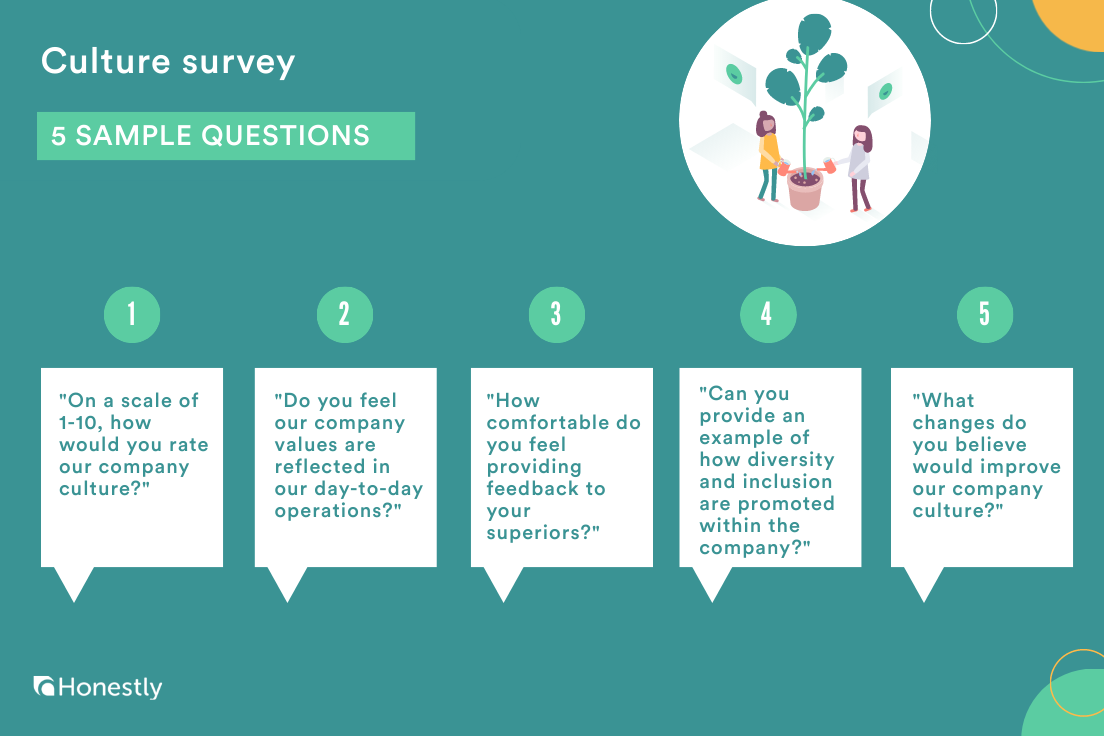
Culture surveys explore the values, beliefs, and behaviors shaping your work environment.
It’s about seeing how these factors blend to create a positive space for your teams.
When to use them:
Culture surveys shine when you’re keen to get a holistic view of your organization’s climate.
Whether you’re looking to pinpoint areas for cultural enhancement or measure the impact of recent changes, they can help you foster a high-performing workplace culture.
Sample questions:
- “How well do you think our company’s values are reflected in our daily operations?”
- “Do you feel our workplace encourages diversity and inclusion?”
- “How comfortable do you feel sharing your ideas and feedback?”
- “In what ways can our company culture improve to better support your work and well-being?”
- “Can you provide an example of how our culture has positively impacted your work experience?”
Onboarding Surveys
Ever think about what makes a first impression last?
Onboarding surveys do just that for new hires.
These surveys are your go-to for understanding the effectiveness of your onboarding process—ensuring newcomers feel welcomed and supported.
When to use them:
Perfect for the initial weeks of a new hire’s journey, these surveys help you fine-tune the onboarding process.
For example, you can use them to assess the clarity of role expectations, the effectiveness of training sessions, and the employees’ overall integration into the team.
Sample questions:
- “Was the onboarding process informative and helpful?”
- “How clear are you about your role and responsibilities?”
- “How supported do you feel in your new position?”
- “What can we improve in the onboarding experience?”
- “How has the onboarding process prepared you for your role?”
Download this free employee onboarding template here.
Exit Surveys
Exit surveys are your gateway to generating insights from employees leaving your company.
They serve as a platform for outgoing staff to share their experiences and reasons for leaving—providing a clear lens on your organization’s work environment and culture.
When to use them:
Exit surveys are most effective when an employee is about to leave the company.
They offer a chance to gather valuable feedback on various aspects of the workplace, from management practices and team dynamics.
Sample questions:
- “What led to your decision to leave the company?”
- “How do you rate your time with us?”
- “In what areas do you feel we could improve?”
- “Did you feel your career goals could be met with us?”
- “What changes would you recommend to enhance our workplace?”
Ad-hoc (topical) surveys
Ad-hoc, or topical surveys, help you drill into a particular theme that’s caught your attention, often stemming from broader engagement survey results.
For example, imagine you spotted a wave of discontent around a new office location based on your annual survey.
It could be a good idea to dig deeper into and run another survey to uncover the reasons behind this sentiment.
When to use them:
Timing for ad-hoc surveys is less about the calendar and more about need.
Seeing a concern in a general engagement survey?
Follow up with an ad-hoc survey for clarity.
You can also use topical surveys when thinking about a potential decision that could affect your team.
For example, you could use it to assess preferences when planning the location for your next team retreat.
Sample questions:
- Can you provide specific examples of when leadership communication was unclear and confusing?
- What activities would you like to participate in during our next team event?
- What aspects of life-work balance do you find the most challenging when working at our company?
- What additional information would you like to receive from leadership to feel more involved and engaged with our company’s direction?
- How do you feel about the idea of modifying the team structure?
- What topics would you like to learn about during the next corporate town hall meeting?
There are many more employee survey types out there—beyond the ones we discussed.
For example, you can run change management surveys, employee opinion surveys, employee wellness questionnaires, and more.
Tailoring these tools to your specific needs can unlock useful insights and drive meaningful change in your business.
And here’s a handy tip: using specialized survey tools like Honestly can simplify this process, letting you use templates and create custom surveys.
How to Design Effective Employee Surveys
Let’s look at the key steps you need to take when creating and distributing workplace surveys.
Step 1: Have Clear Goals in Mind
It’s crucial to kick things off with specific goals to ensure your survey hits the mark and gathers actionable insights.
Without clear objectives, it’s easy to end up with a lot of data but no clear direction.
For example, you could decide to focus on:
- Assessing overall employee satisfaction
- Understanding the effectiveness of communication within the company
- Identifying drivers of employee engagement
- Collecting feedback on company policies and benefits
These objectives serve as your survey’s North Star, guiding each question and ensuring every answer brings you closer to actionable insights.
Step 2: Choose The Right Survey Type
Once you have a clear goal in mind, it’s time to select the optimal survey format.
As we saw earlier, there are numerous types of employee surveys you can choose from.
For example, imagine you were looking to assess the effectiveness of your employee benefits plan.
In this case, you could run a satisfaction survey and analyze the overall sentiment.
Or, you could be trying to identify the best candidate for a promotion and opt for a performance review survey format.
Step 3: Design the Questionnaire
After selecting the right employee survey format, move to crafting your questionnaire.
This is where your survey begins to take shape, transforming from a concept into a powerful tool.
When writing down the survey questions, focus on the following:
Add direct and relevant questions
Each survey question should tie back to your survey’s primary objectives.
Here are some sample questions based on the survey objectives:
- For assessing employee satisfaction: “On a scale of 1 to 10, how satisfied are you with your current work-life balance?”
- Understanding communication effectiveness: “How well do you feel the company communicates important updates and information?”
- Identifying engagement drivers: “What motivates you to go above and beyond in your job?”
It’s also important to prioritize questions that generate actionable insights you can actually act on.
For example:

Integrate varied response formats
Incorporating a mix of question types (e.g., multiple choice, Likert scales, open-ended) keeps the survey engaging and allows for a broader range of feedback.
Ensure clarity
Avoid ambiguity by making questions straightforward and easy to understand.
This ensures that responses are accurate and meaningful.
For example:
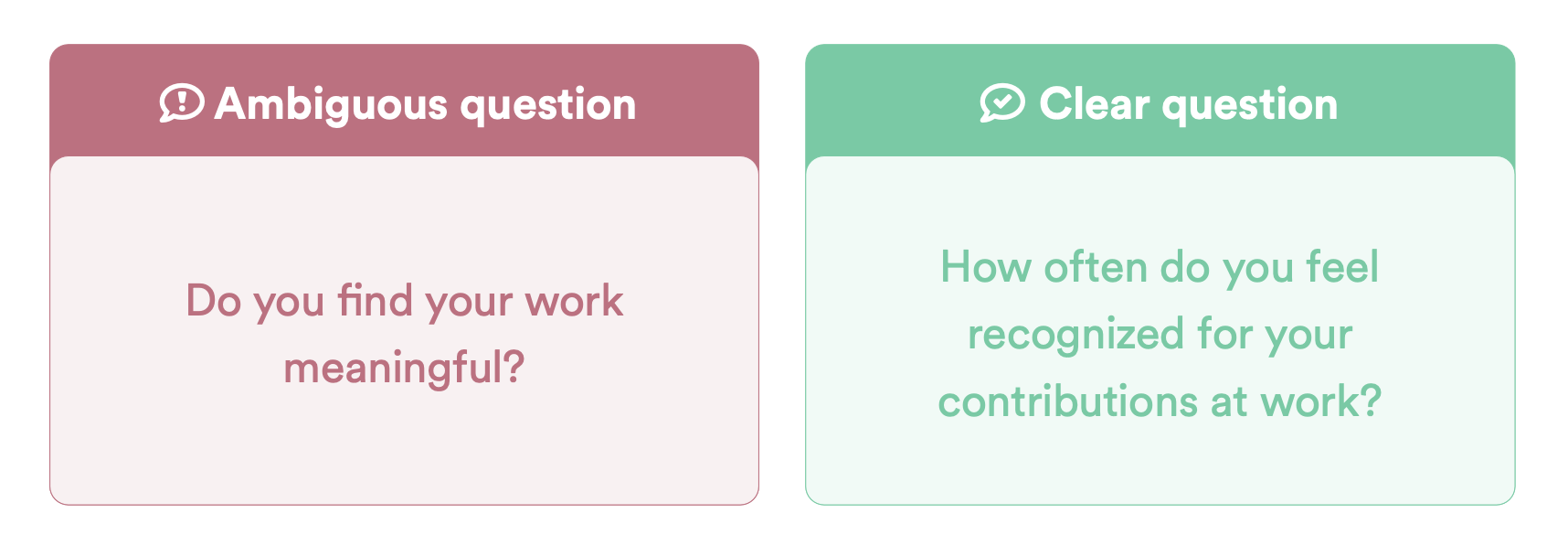
Avoid asking questions that people could feel uncomfortable answering
When crafting your employee surveys, aim for a balance that encourages honest feedback without making anyone uncomfortable.
It’s key to fostering an environment where every voice feels heard, valued, and respected.
For example:
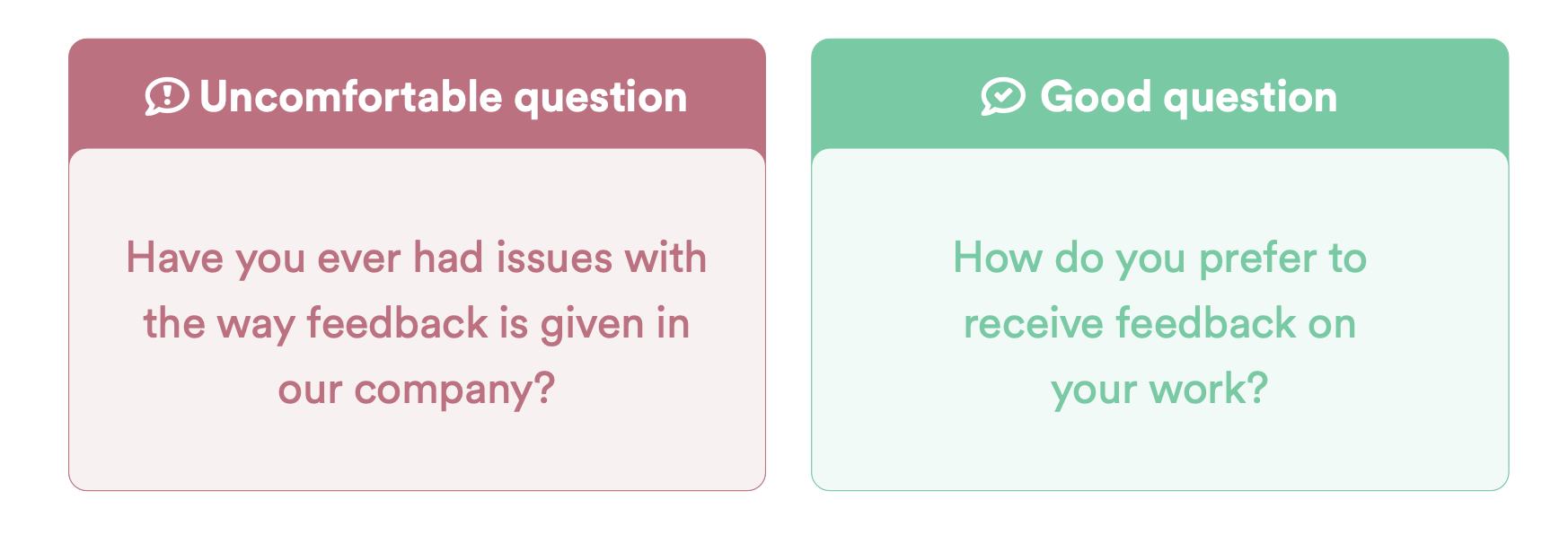
If you’re using employee survey tools like Honestly, you can save time by using scientifically designed survey templates.
For example, its employee engagement template offers a list of essential questions you should include.
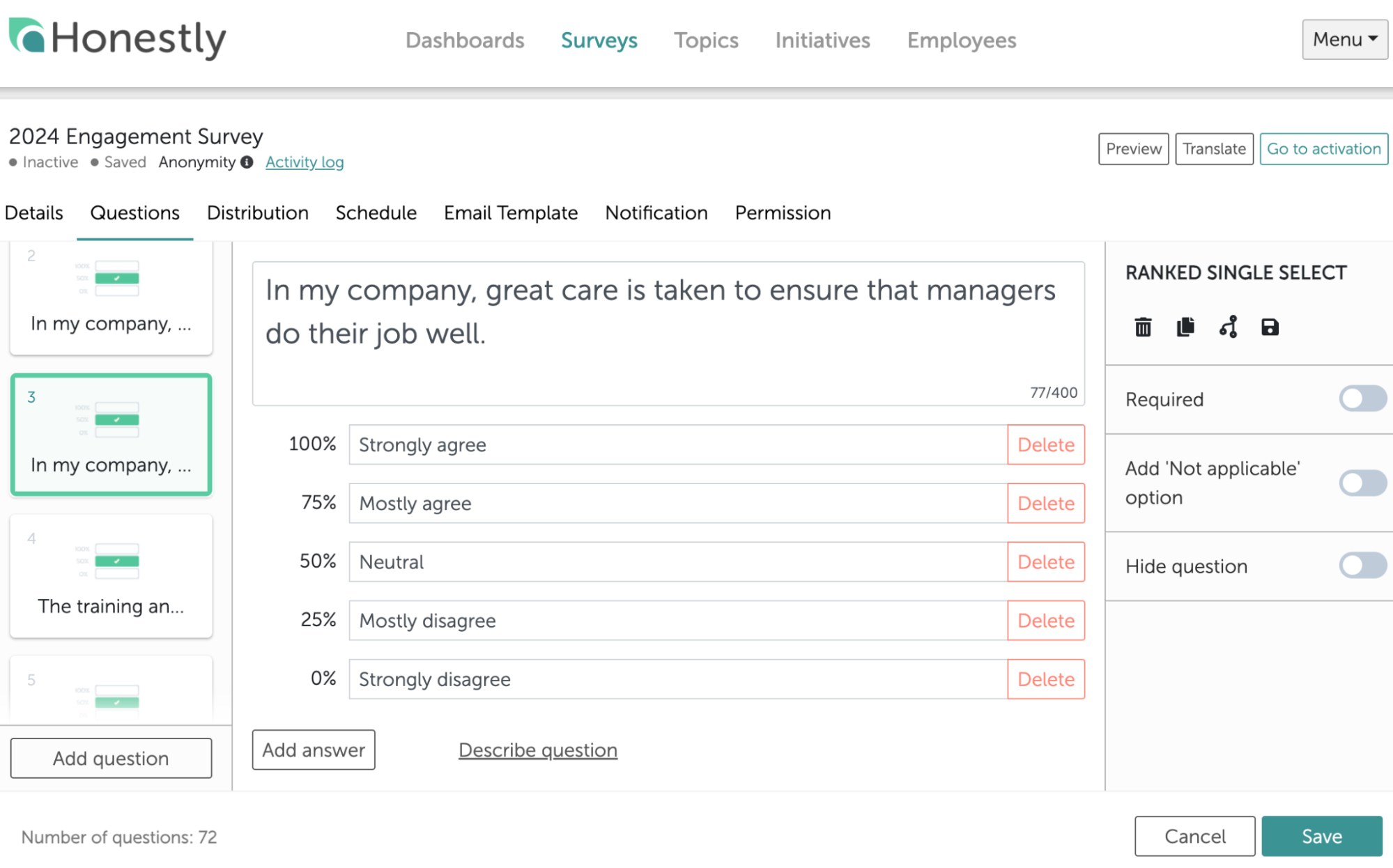
You can then customize it the way you want and boost efficiency.
Step 4: Ensure Anonymity and Confidentiality
Keeping things anonymous in your surveys is like making a promise to your team that their thoughts and opinions are safe with you.
It’s crucial because, let’s face it, we all want to know our words won’t come back to haunt us.
So, as you roll out your next survey, remember to highlight how you’re protecting their responses.
It’s the little things like this that can really make a difference in how comfortable everyone feels chipping in.
Here’s how you can do it:
- Guarantee that responses cannot be traced back to the individual
- Make it clear that the information gathered will be used exclusively for improvement and not for evaluation
Step 5: Pilot the Survey
Before launching your survey to everyone, consider running a trial version first.
This step lets you check if the questions are clear, the survey length is appropriate, and everything flows smoothly.
Start by selecting a small, diverse group from your team to take the survey.
Then, analyze the results and check whether any changes are needed.
This way you nail down the specifics and ensure your survey will actually deliver the insights you’re after.
Plus, it shows your team you’re committed to getting it right, valuing their time and feedback from the get-go.
Step 6: Distribute The Survey
Congrats, you have your survey ready to go!
Now it’s time to send it out to everyone.
You can do it by sending an email or sharing the survey via a Slack channel or any other Intranet platform.
This step is pretty straightforward, but it’s more than just hitting the send button.
It’s important to make sure your team knows that this survey is important and that you’re looking forward to hearing what they’ve got to say.
Here are some tips:
- Start with a little excitement
Let your team know the survey is coming and why it’s important. It’s a chance for their voices to be heard and to make a real difference in the workplace.
- Make it feel personal
When you send out that survey link, make it feel like you’re talking directly to them.
A quick note saying you value their input can go a long way.
- Explain the impact
People are more likely to take part if they know their feedback is going to be taken seriously.
- Remind them it’s anonymous (when applicable)
As we have already established, anonymity and privacy are extremely important when it comes to team feedback surveys.
Make sure to highlight it in your communication assets when promoting the survey.
- Consider adding a thank you
Whether it’s a small thank you note or a chance to win something, a little thank you can encourage more people to respond.
- Keep the reminders friendly
If you need to send out a reminder, keep it casual and don’t pressure your employees.
Here’s a great example of a clear and engaging employee survey distribution email:
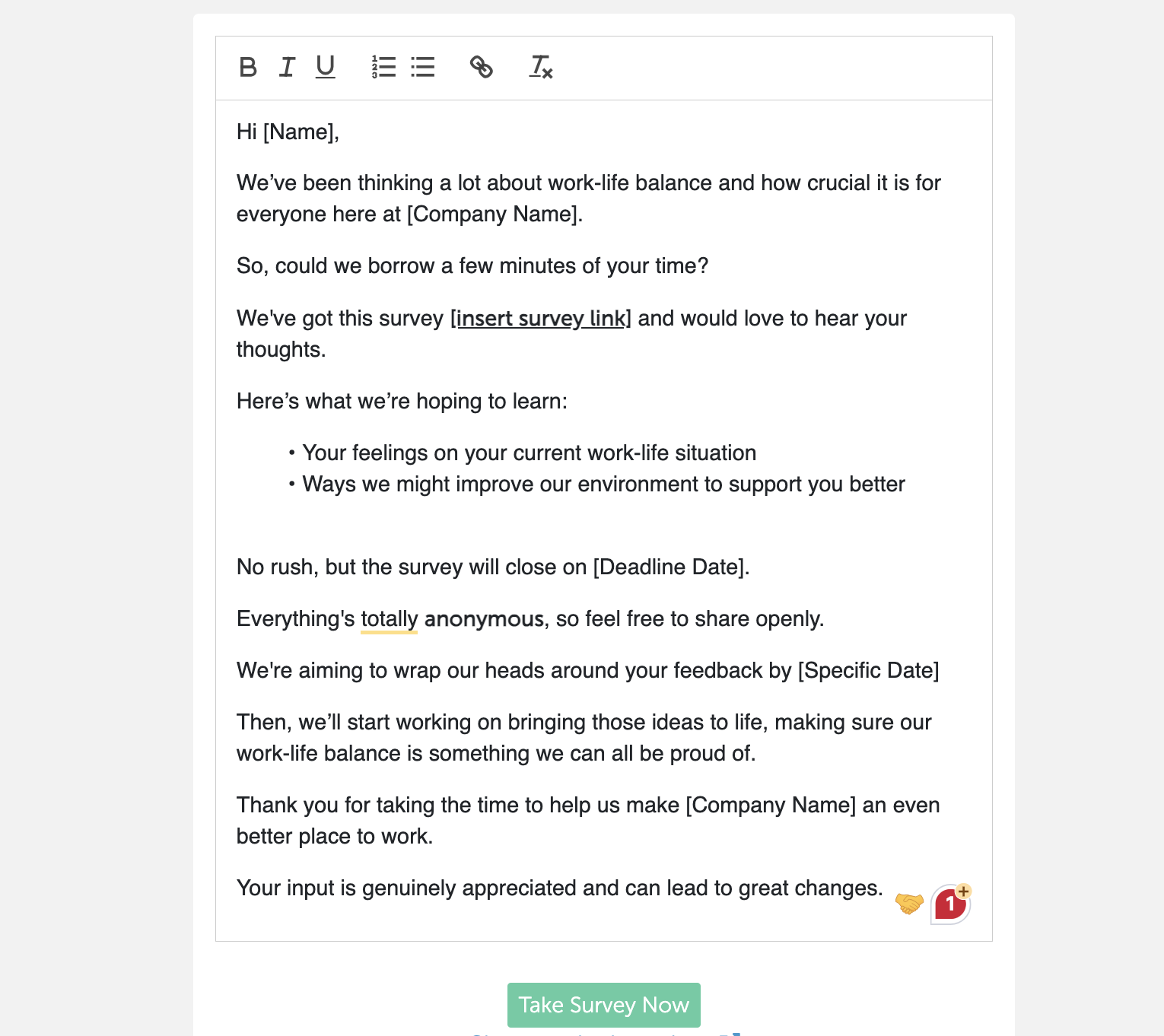
If you’d like to automate this step, use tools like Honestly.
First, the tool will help you quickly select the segments for your survey distribution.
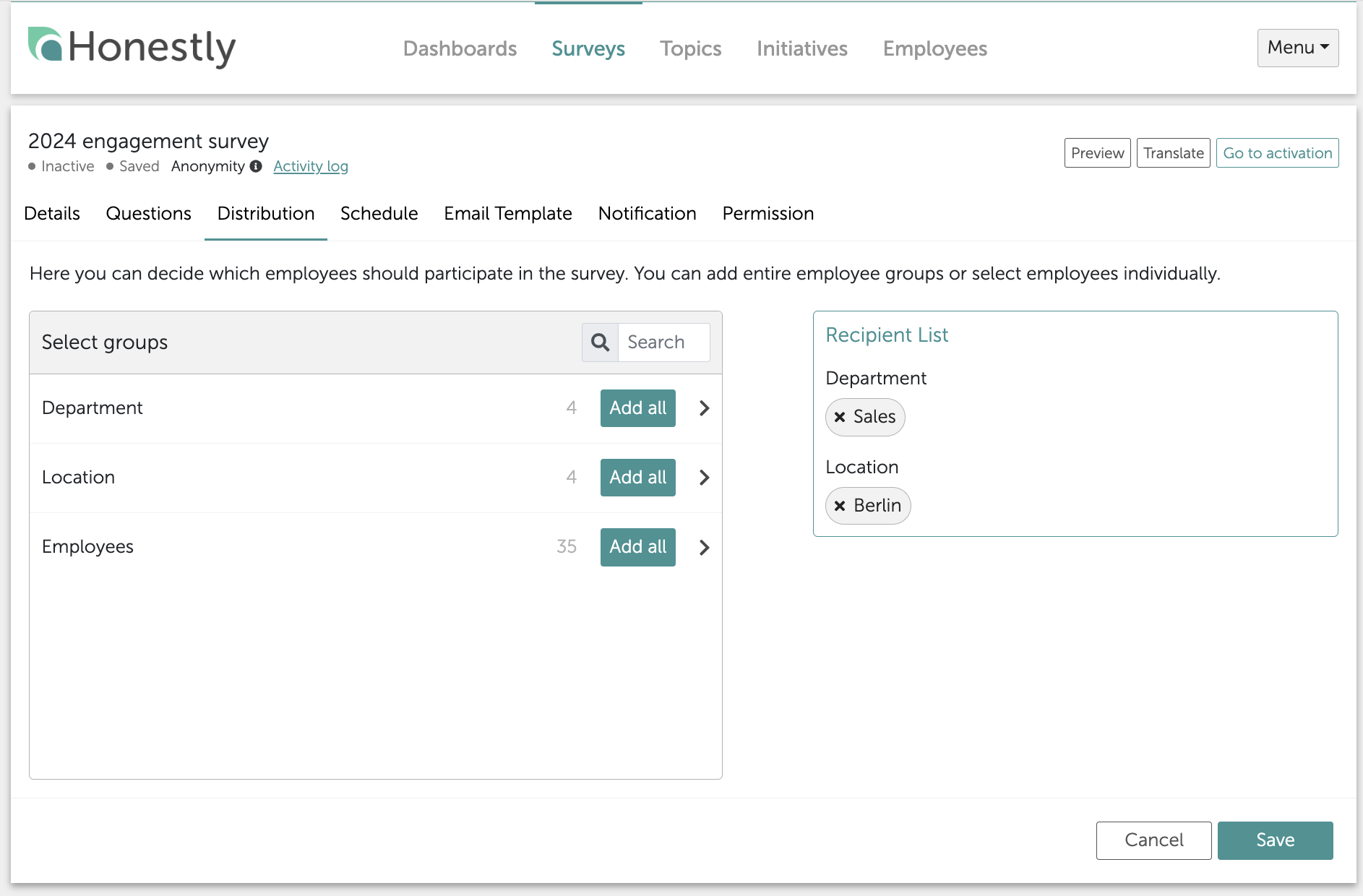
Next, you can schedule your email announcements and notifications.
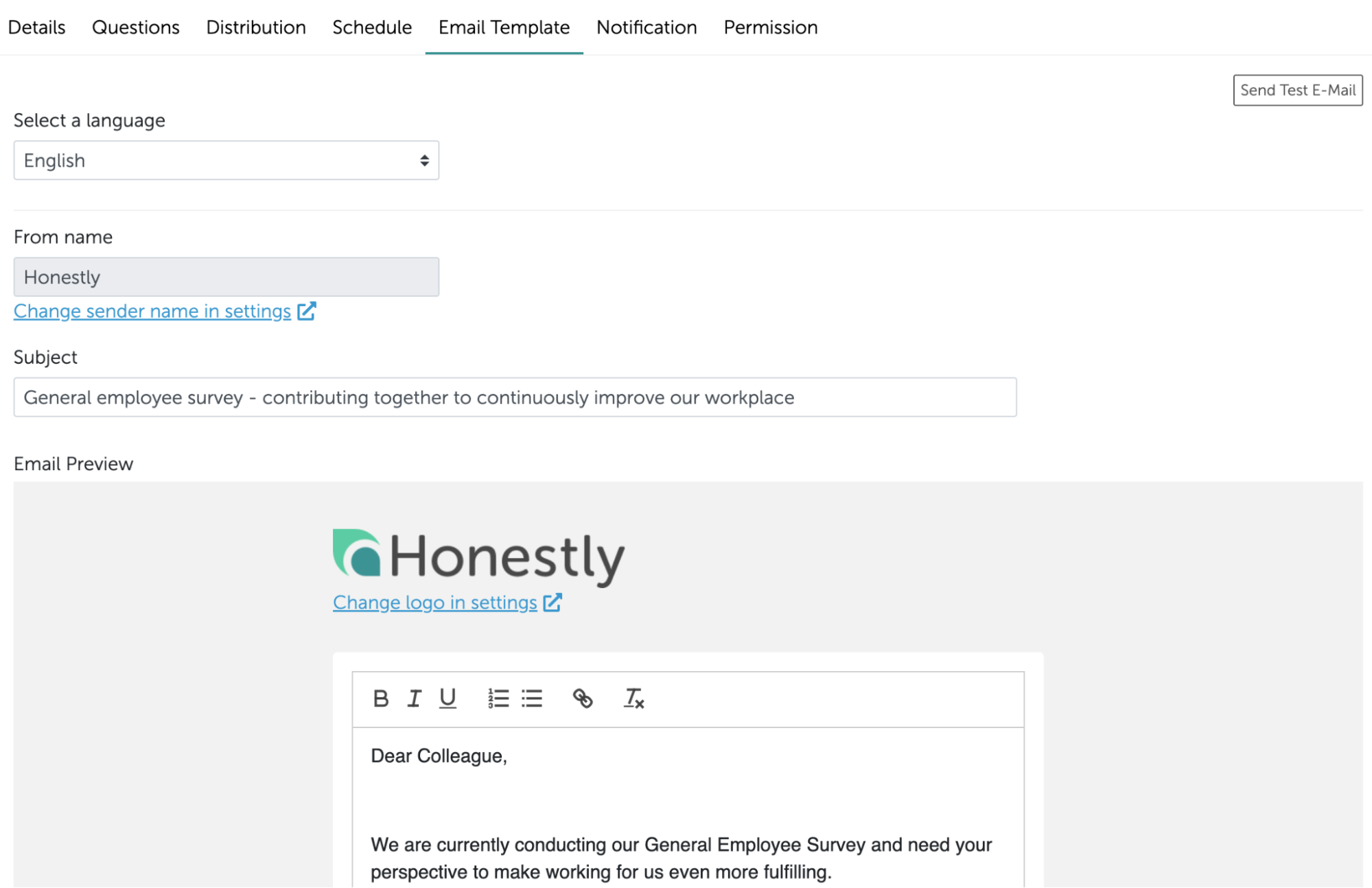
Step 7: Analyze The Results
Once your survey has closed, the next crucial step is to examine the results.
This stage is where the data gathered transforms into actionable insights, helping to steer your organization in the right direction.
Here are some tips for you to follow:
- Begin with a 360-degree overview
Start by examining the overall response rates and the distribution of answers across different questions.
This high-level view can immediately highlight areas of strength and/or concern.
For instance, if a large proportion of your employees report dissatisfaction with work-life balance, this flags an area requiring immediate attention.
- Dive deeper with a detailed analysis
After the initial overview, dig deeper into the data.
Look for trends and patterns present within different departments, roles, or demographic groups.
This analysis can uncover specific insights that might not be apparent from the overall data.
For example, if one department shows higher levels of engagement than others, you might want to look into it.
- Compare against benchmarks
If possible, compare your results with industry benchmarks or past survey results.
This can provide context for your findings, helping you understand whether certain scores are within a normal range.
- Identify actionable insights
Last but not least: Look for feedback that directly ties back to your strategic objectives.
Make sure to identify opportunities and issues that are directly connected to the goals of your survey—and can be realistically addressed.
If you’re using Honestly, you can study your data over time and compare various reports using unlimited dashboards.
You can also customize each dashboard the way you want and adapt it for different user types.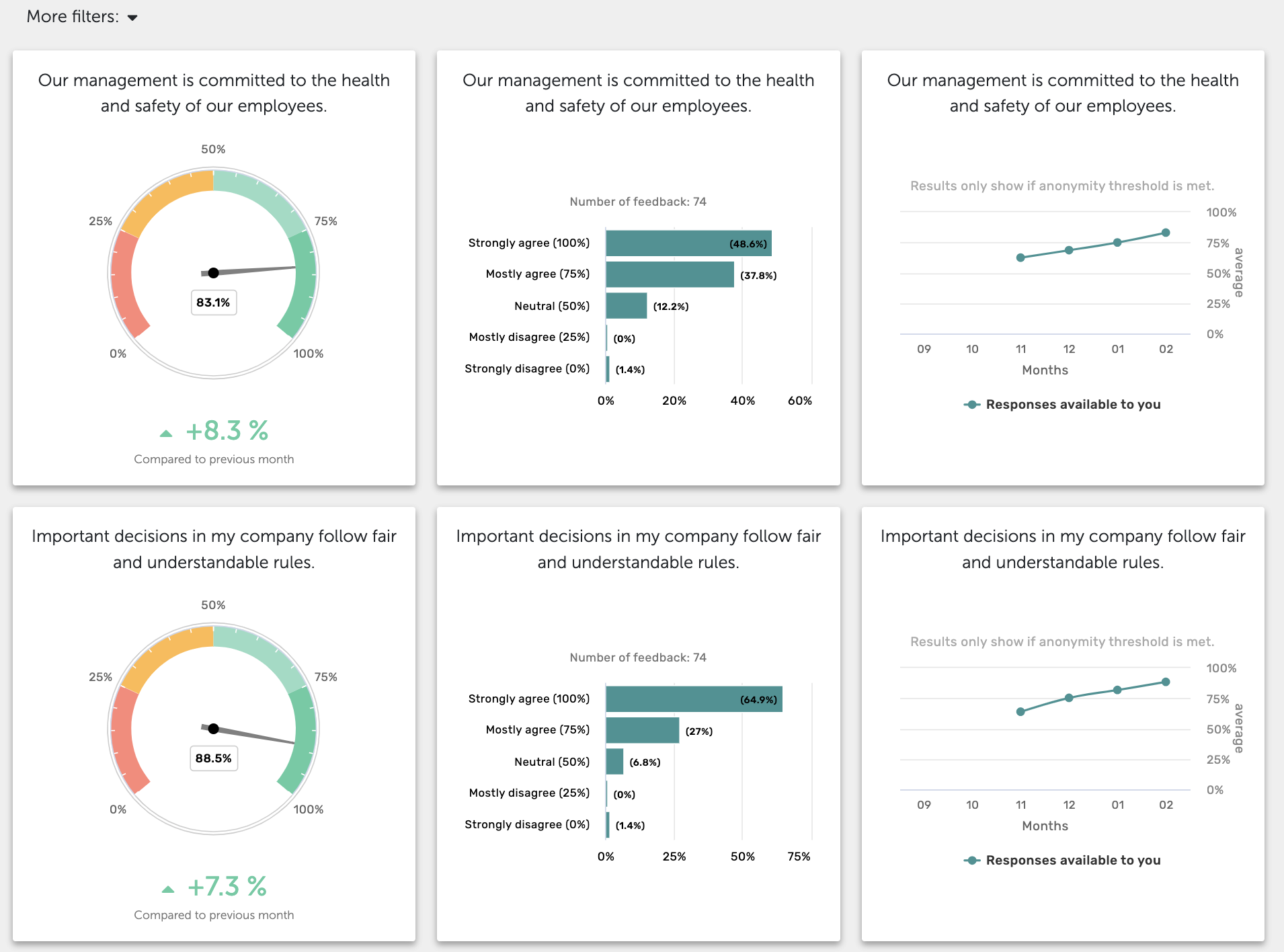
Using heatmaps, compare employee sentiment across departments, locations, etc. and look for outliers.
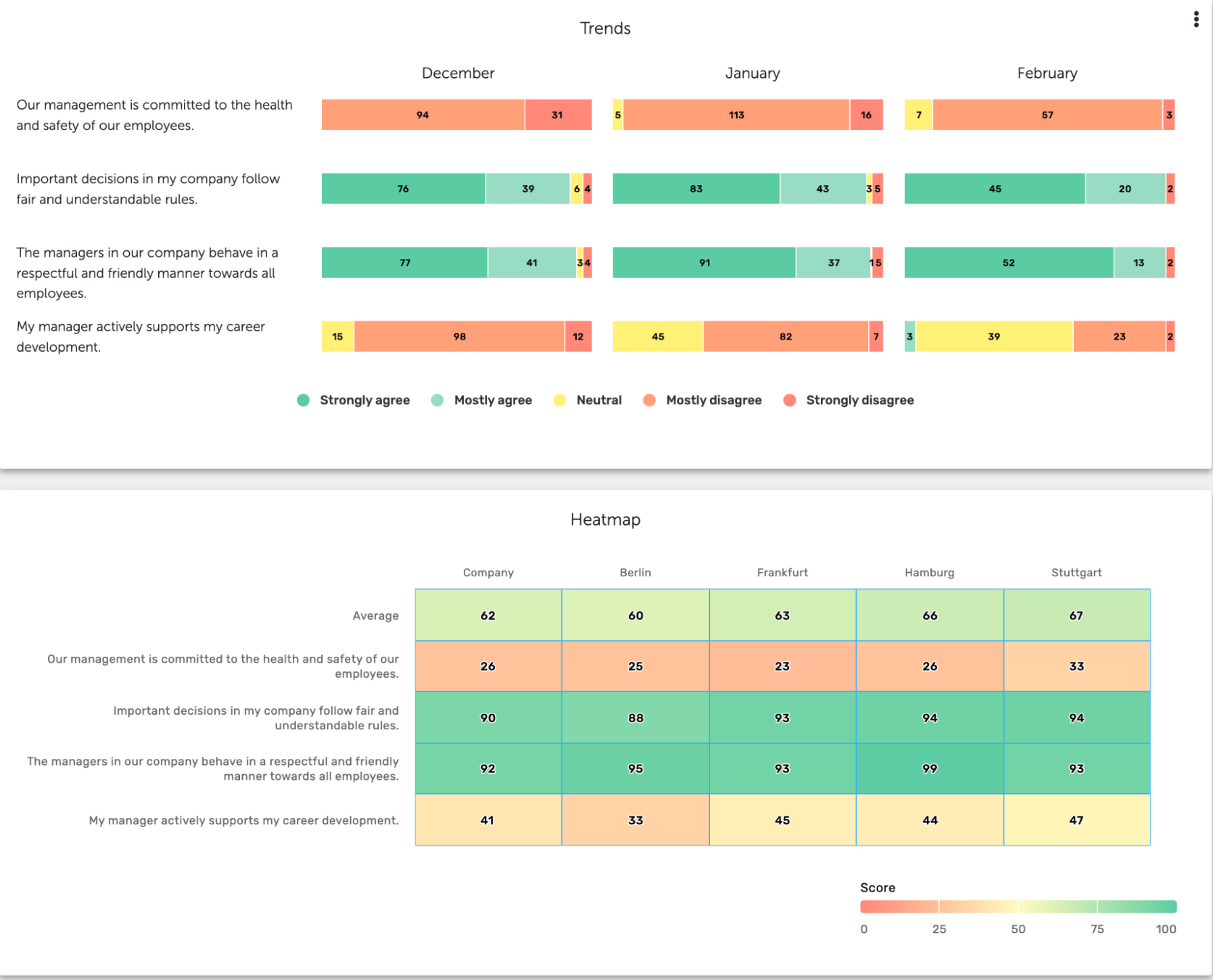
The tool also features powerful AI to analyze your open-ended questions and identify common themes.
So, there’s no need to spend hours reading through every survey response.
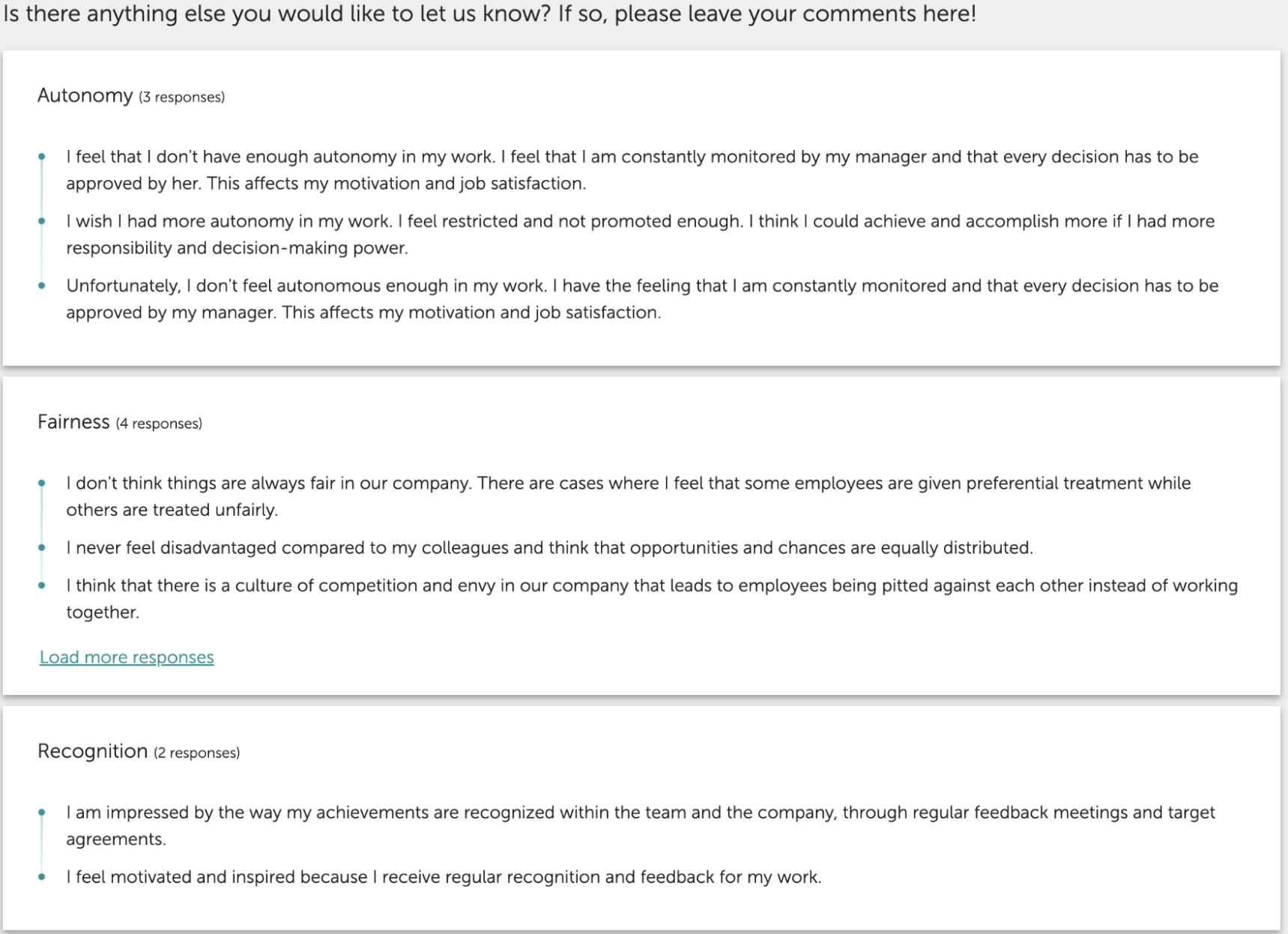
Finally, feel free to download your data and analyze it elsewhere—without losing privacy settings.
Step 8: Communicate Findings
After analyzing the survey results, it’s crucial to share these insights with the organization.
Why?
Because transparency fosters trust and shows that you value employee feedback.
1. Prepare a concise summary
Start with crafting a summary of the key findings.
This should be straightforward and easy to understand.
2. Select the right channels
To ensure this information reaches everyone, use a mix of communication channels.
For example, an all-hands meeting can create a space for live discussion and immediate questions.
At the same time, an email or a Slack channel update will let you reach employees who couldn’t attend.
With tools like Honestly, you can share the right amount of data with the right people within your company. For example you can share results with a chosen team or only the managers via customized dashboard. This ensures privacy, but also enables specific people to act on the findings.
3. Emphasize the next steps
Make sure to outline the actions the organization plans to take in response to the survey findings.
It’s key to proving your commitment to making a change.
Step 9: Take Action
Finally, it’s time to take action.
Using the insights you collected, prioritize initiatives that promise the biggest impact on employee satisfaction and engagement.
Here’s what you’ll need to do.
1. Develop an action plan
Outline specific initiatives, assign responsibilities, and set deadlines.
2. Involve employees
Engaging employees in changes promotes a sense of ownership.
How can you do it?
Consider forming teams or working groups to contribute ideas and execute solutions.
3. Share progress
Keep your teams informed about the status of these actions.
4. Celebrate achievements
Remember: It’s important to recognize progress and show appreciation for collective efforts
Step 10: Follow Up
Once you’ve rolled out those changes, it’s time to circle back and track progress.
Why not ask again?
Conducting follow-up surveys is essential to assess what’s working and what’s not.
You could come up with a few things. For example:
1. Check in with another survey
A little while after making those changes, send out another survey.
It’s a great way to keep the conversation going and see if those adjustments are hitting the mark.
2. Look at the before and after
Take a look at how the new survey responses stack up against the first set.
And there you have it, the roadmap to turning feedback into action and making our workplace shine.
Finally, let’s look at a few best practices for building employee surveys that hit the mark.
Employee Surveys Best Practices
Here are a few dos and don’ts of running employee surveys.
In a nutshell, it’s all about collecting relevant insights in a way that feels right for everyone involved.
1. Boost Participation
Engaging as many employees as possible is one of the most important steps.
Here’s how you can do it.
First, highlight the importance and goals of each survey. Make sure to mention it’s anonymous to create a safe space for your employees to share their thoughts.
Showcase the real changes it could bring and why they should care.
Then, make your survey easy, straightforward, and convenient for employees to participate.
Last, but not least - follow up on the feedback you receive and use insights to create an action plan.
Communicate the findings and the exact steps you will take. This will make people feel like you’ve not only listened, but also truly care about making the changes that matter.
2. Use Specialized Survey Tools
Online survey tools like Honestly can help you create better surveys faster—and analyze feedback without extra effort. Plus they ensure anonymity which makes people feel comfortable to share honest opinions.
Automation can save you lots of time and resources, which you can then use to make changes in your company.
3. Commit to Action
Acting on feedback is how we build trust.
It shows everyone that their thoughts truly matter and helps create a workplace where open conversation is the norm.
Make sure to conduct employee surveys when you’re ready to act on your findings—and be proactive when developing solutions.
4. Train Your Leaders
Make sure to equip your managers with the skills to understand and act on survey findings.
This training turns data into action, helping you drive positive change.
Final Thoughts
Conducting employee surveys allows you to turn staff feedback into your roadmap for growth.
Every question asked and every action taken following the survey sends a clear message:
“We’re listening, and yes, we’re all in this together.”
To make sure your workplace surveys move the needle, keep them concise and clear, follow specific objectives, and act on your findings.
Remember, it’s key to design the right questions and analyze the results in detail.
To streamline those processes, use online survey tools with powerful templates and data analytics capabilities.

